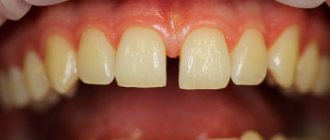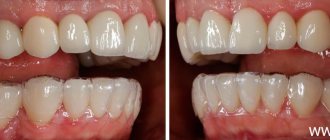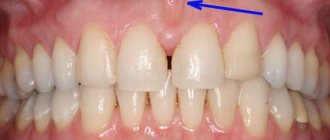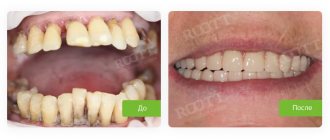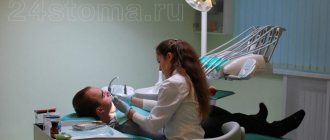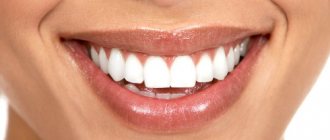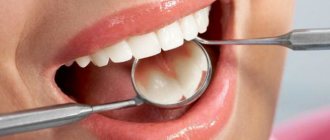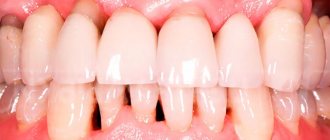Content:
- Causes
- How does pathology manifest itself?
- How is the treatment carried out?
- Surgical techniques
- Additional treatments
- Preventive measures
If the gums have become detached from a wisdom tooth or any other unit, you need to visit a doctor as soon as possible.
When the soft tissues subside, the neck remains unprotected and exposed. It is not covered with a thick layer of enamel, so it immediately begins to react sharply to temperature changes. The situation is aggravated by the fact that food debris gets into the formed periodontal pocket. They accumulate there and serve as an ideal breeding ground for pathogens. If such a pocket is not cleaned in a timely manner, it will increase in size. Then it will come to edentia.
FIRST SIGNS
The optimal flushing gap (norm of a fraction of a millimeter), when installed correctly, ensures:
- proper fixation of the device;
- high-quality hygiene;
- protection against manifestations of pathologies of periodontal tissues;
- long-term operation of the product.
Normally, this temporary effect should not cause any complications.
You should be concerned after installing a prosthesis in the following cases:
- discomfort appears and pain occurs in certain areas of the oral cavity;
- the structure has changed its position in the mouth and this is noticeable;
- increased sensitivity of tissues and teeth to irritating foods (cold, hot, spicy, salty) and temperature changes;
- bothered by itching and burning;
- manifestations of a lisp develop;
- a whistle is heard from the mouth during a conversation;
- The general condition of the oral cavity is only getting worse every day.
The listed undesirable manifestations can be observed at the site of localization of the orthopedic product or beyond.
If the first symptoms appear, it is important to immediately seek help from a specialist.
If you have any mistrust in your dentist or orthopedist, you can get alternative advice and assistance at another medical institution.
Causes
Exposed necks indicate periodontal damage. Most often the problem occurs for the following reasons:
- Genetic predisposition. When exposed to this factor, a person can very diligently monitor the health of his smile, but will still periodically encounter unpleasant dental symptoms.
- Mechanical and thermal damage. The habit of gnawing on foreign objects, eating too hot food, using a hard brush are all provocateurs that contribute to irritation.
- Poor oral hygiene. If the patient neglects basic hygiene rules, a lot of plaque is deposited on the crowns. Pathogenic microorganisms spread in it. The gums become irritated, turn red, and bleed. Gradually they begin to move away from the teeth. It is important to use a brush and paste twice a day, and undergo professional hygiene at the dentist’s office annually.
- Poorly performed prosthetics or mistakes made during filling. It is necessary that the dentures fit as tightly as possible to the bases and do not fall under pressure, otherwise the gums will be constantly injured and inflamed.
- Curvature of the bite, problems with teething “eights”, uneven edges of the crowns. All this causes the gums to move away from the tooth.
- Unbalanced diet. If a person eats only soft foods and sweets, he does not actively chew food. As a result, blood circulation in the oral tissues slows down, less saliva is released, and periodontal deposits are actively formed. These are the prerequisites for a recession.
- A large amount of tartar. Despite the fact that dentists recommend removing stones annually or even more often, many patients do this very rarely. You shouldn't wait until a serious problem arises. It is easier and cheaper to prevent it than to treat it later.
- Hormonal imbalance. Most often, this reason concerns women, for example, during pregnancy, menopause, and breastfeeding. With hormonal fluctuations, the mucous membranes become especially vulnerable. Even minor mechanical impacts cause recession.
Don't forget about the negative effects of tobacco smoke. According to statistics, smokers are much more likely to suffer from gum disease and exposed necks. They accumulate plaque faster. Therefore, if you want to have a healthy smile and visit the dentist less often, stop smoking.
Recession classification
Receding gums are classified according to their causes into the following types:
- Traumatic - appears as a result of mechanical damage to the mucous membranes. As a rule, the injury is associated with a hard toothbrush and improper brushing technique, which leads to systematic damage. Other common causes of injury include incorrectly installed orthopedic structures - veneers, crowns, etc. Sometimes injury is associated with protruding edges of fillings and elements of braces. It is important to understand that bite defects are also a common cause of recessions: improper distribution of chewing load leads to changes in tissues. Injuries can also be associated with direct pressure on the gums of the teeth. And finally, another group of injuries includes burns, for example, those associated with unsuccessful home bleaching.
- Symptomatic - in this case, the prolapse is associated with some pathological process and serves as its symptom. Usually we are talking about diseases of the gums and periodontal tissues: gingivitis, periodontitis or periodontal disease. They affect mucous membranes and soft tissues, disrupting their trophism. The situation is aggravated by dental deposits in the places where the gums adhere to the tooth; as a result, the tissue simply peels off from the surface of the tooth and the tissue level drops. More rare pathologies manifested by gum recession include other diseases, for example, diabetes mellitus, leukemia.
- Physiological - it develops as a result of a general metabolic disorder, including metabolic disorders in periodontal tissues. In this case, we are talking about the natural processes of aging. However, sometimes receding gums develop at a young age due to the individual structural characteristics of the dental system. The most striking example is a shortened labial frenulum, which leads to tissue tension.
Based on the severity of a recession, it is also classified into three categories:
- light: tissue loss up to 3 mm;
- average: 3−5 mm;
- heavy: more than 6 mm.
Based on the localization of the pathological process, recessions are divided into localized and generalized. In the first case, receding gums are associated with trauma and spread to one or more closely spaced teeth. As a rule, the outer side of the teeth is affected, and the defect is noticeable when smiling.
In the generalized form, the pathology covers the entire dentition on one or both sides. It is more often observed in elderly patients, as well as in people with periodontitis and periodontal disease.
Ask a Question
How does pathology manifest itself?
Symptoms depend on how far the gum has receded from the tooth. Most often patients complain of:
- increased bleeding and soreness of the gums;
- bad breath that cannot be eliminated with standard hygiene products;
- taste of pus;
- separation of purulent masses from the inflammatory focus;
- the appearance of deep periodontal pockets;
- loosening of individual units.
In the first days of the disease, patients may not experience any significant discomfort. They are just beginning to notice that in certain areas of the jaw the tissue seems to have sagged and become less voluminous. Because of this, the crown part of the tooth, on the contrary, looks elongated.
If the gums have peeled off, there is no need to try to do anything on your own. Without qualified help, it will still not be possible to cope with the recession. Postponing competent therapy until later is fraught with even more serious violations.
Symptoms and forms of the disease
Today, when diagnosing the severity of the disease, the Miller classification is used, which involves 4 stages of gum recession.
- Visually, gum loss is hardly noticeable (or completely unnoticeable) and appears only in the area of contact between the tooth and gum.
- The defect appears slightly in the area of contact between the gum and the neck of the tooth (the level of the attached gum decreases by 1-2 mm). The gums between the teeth remain at the same level.
- The gums recede by 3 mm or more. The necks of the teeth are slightly exposed, but the bone level does not decrease. At this stage, the gums often recede and bleed.
- The most severe stage, when the gums recede by 5 mm or more, the roots of the teeth become visible. Mobility of the teeth is observed, which at this stage of the pathology is often generalized and involves several teeth.
At advanced stages, pathology can be noticed visually, especially when the gums on the front teeth recede. If the pathology is at the beginning of its development, a number of additional symptoms help to detect it.
- Inflammatory process, bleeding.
- Formation of periodontal pockets.
- The sensitivity of the enamel has increased.
- The presence of a thick layer of dental plaque.
- Unhealthy whitish tint of gums.
Only a doctor can make an accurate diagnosis (using modern technologies), so if you have at least one symptom, you should not postpone your visit to the clinic. Of course, everyone is interested in the question of what to do if the gums on a tooth have receded and what treatment should be chosen. There are two directions: therapeutic and surgical. The choice depends on the severity of the pathology and the underlying disease that led to soft tissue atrophy.
How is the treatment carried out?
Some people think that they can be cured with regular rinses. Unfortunately, it is not. The first step is to make an appointment with a dental hygienist. The doctor removes soft and hard deposits from the surface of the crowns and subgingival area in one session.
The following methods are used to remove stone:
- Instrumental. Involves the use of special scrapers that remove deposits. It is considered outdated and is extremely rarely used by doctors, as it is traumatic.
- Ultrasonic. Using an ultrasonic scaler, the doctor crushes the stones into tiny particles. This equipment produces waves of the required frequency, which easily destroy dental plaque.
- Sandblasting. It is the most modern and safe. The doctor delivers the cleaning solution under high pressure. Abrasive particles wash away deposits from crowns and effectively flush out existing pockets. The advantage of the technique is to achieve the effect of teeth whitening by one or two shades.
If the hygiene procedure does not help and the problem is serious, the patient is prescribed surgical treatment.
What to do if the gum has moved away from the tooth
As trivial as it may seem, you will have to make an appointment with the dentist.
At home, you can only temporarily minimize the unpleasant manifestations of the disease in the following ways:
- antiseptic rinses (potassium permanganate solution, Chlorhexidine);
- cold compresses (you can apply cold to the inflamed area to relieve pain);
- taking painkillers (for severe pain, Tempalgin, Sedalgin, Ketanov, Solpadein, etc. will help).
What not to do:
- warm and hot rinses (in a warm environment, microbes will multiply even more intensely);
- warming compresses.
Whenever possible, hygiene procedures should be continued to prevent bacterial growth. If brushing your teeth is not possible, it is recommended to rinse your mouth with a paste diluted in water.
Surgical techniques
In advanced situations, plaque removal alone is not enough. Then there may be a need for open or closed curettage. It is indicated if the gums are very severely detached from the dental neck and the bone structure is changed.
The dentist-surgeon treats the lesion with an antiseptic, makes a small incision and removes purulent deposits and affected tissue . Then the gum is sutured. All manipulations are performed under local anesthesia. This means that the patient is conscious and can communicate with the doctor, but does not feel pain.
For a speedy recovery after curettage, antibiotics and mouth rinsing with an anti-inflammatory solution are prescribed. If the pain after surgery is very severe, the patient can use painkillers.
Additional treatments
Considering that gums become inflamed for various reasons, it is important to try to find out the provoking factor. Then the risk of relapse of dental pathology can be reduced to a minimum.
If the doctor determines that the disorder is related to hormonal levels, it is necessary to select hormonal therapy . In case of malocclusion, consultation with an orthodontist is indicated. If the diet is unbalanced, the patient is told what the diet should be like after recovery.
Often, when fighting gum that has receded from a tooth, anti-inflammatory drugs, immunomodulators, glucocorticosteroids, and antiseptics are used. It is very important that the patient strictly follows all medical prescriptions and does not engage in amateur activities. An integrated and responsible approach to treating recession is a guarantee of a speedy recovery.
If the tissues become so inflamed that the teeth begin to loosen, splinting may be required. If there is a deficiency of bone tissue, their deficiency is compensated with special compounds.
Preventive measures
To prevent gums from moving away from the tooth, you need to follow simple recommendations:
- brush your teeth twice a day;
- use a properly selected brush and paste;
- visit the dentist in a timely manner;
- prevent tartar from forming;
- no smoking;
- eat more solid foods;
- Healthy food.
At the first sign of a recession, you should see a doctor. Then the disease can be stopped very quickly.
